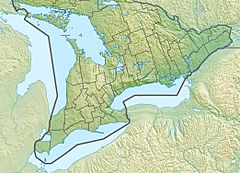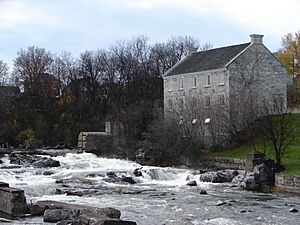Bonnechere River facts for kids
Quick facts for kids Bonnechere River |
|
|---|---|

Bonnechere River in Renfrew with low water level
|
|
|
Location of the mouth of the Bonnechere River in southern Ontario
|
|
| Other name(s) | Bonnechère River |
| Country | Canada |
| Province | Ontario |
| Regions | |
| County/District |
|
| Physical characteristics | |
| Main source | McKaskill Lake Geographic Clancy Township, Unorganized South Part, Nipissing District, Northeastern Ontario 371 m (1,217 ft) 45°45′01″N 78°03′35″W / 45.75028°N 78.05972°W |
| River mouth | Ottawa River Horton, Renfrew County, Eastern Ontario 72 m (236 ft) 45°31′11″N 76°33′28″W / 45.51972°N 76.55778°W |
| Length | 145 km (90 mi) |
| Basin features | |
| Progression | Ottawa River→ Saint Lawrence River→ Gulf of Saint Lawrence |
| River system | Ottawa River drainage basin |
| Basin size | 2,400 km2 (930 sq mi) |
The Bonnechere River is a river in Ontario, Canada. It flows from Algonquin Provincial Park all the way to the Ottawa River. The river is about 145 kilometers (90 miles) long. Its name comes from a French phrase, "bonne chère", which means "good eating" or "good cheer".
Contents
Journey of the Bonnechere River
The Bonnechere River starts its journey in Algonquin Provincial Park at a place called McKaskill Lake. It then winds its way through different areas. Along its path, it passes through several rapids and waterfalls. These include the Crooked Chute, High Falls, and Stacks Rapids.
Lakes and Towns Along the River
As the river flows southeast, it leaves Algonquin Park. It then enters Renfrew County. The river flows into Round Lake, where another river, the Sherwood River, joins it. After Round Lake, the Bonnechere River reaches Golden Lake. This lake is home to the town of Killaloe and the Algonquins of Pikwàkanagàn First Nation.
The river continues its journey, forming a natural border between different townships. Finally, the Bonnechere River reaches its end. It flows into Lac des Chats, which is part of the larger Ottawa River. The river drains an area of about 2,400 square kilometers (927 square miles).
River's History and Use
For many years, the Bonnechere River has been important to the local area.
Logging and Hydroelectricity
In the 1800s, the river was used to transport large white pine logs. These logs were floated downstream from the forests. Today, the river is still used to create power. Several hydroelectric plants have been built along the river. These plants use the river's flowing water to generate electricity.
Nature and Fun on the River
The Bonnechere River area is rich in natural beauty and offers fun activities.
Bonnechere Caves
Near the village of Eganville, Ontario, you can find the Bonnechere Caves. These caves were formed from ancient limestone. They are a cool place to explore and learn about geology.
Provincial Parks
There are two provincial parks along the river. The Bonnechere River Provincial Park protects a 23-kilometer section of the river. The Bonnechere Provincial Park is located on Round Lake. Both parks offer chances to enjoy nature.
The Ottawa-Bonnechere Graben
Most of the Bonnechere River flows through a special geological area. This area is a 175-million-year-old rift valley. It is called the Ottawa-Bonnechere Graben. A rift valley is a lowland region that forms where Earth's tectonic plates pull apart.
Songs About the River
The beauty of the Bonnechere River has inspired artists. Songs have been written about it, including "In The Arms Of The Bonnechere River" by Terry McLeish.
The Chutes: River Waterfalls
The Bonnechere River has five main waterfalls, which are called "chutes."
- The First Chute is where the Bonnechere River meets the Ottawa River at Castleford.
- The Second Chute is in Renfrew. This waterfall has a small hydroelectric dam.
- The Third Chute is in Douglas. It also has a small hydroelectric dam.
- The Fourth Chute is in the small village of Fourth Chute.
- The Fifth Chute is in Eganville.
The Annual River Run
Every year, the Bonnechere River hosts a fun event called the "river run." This event takes place between the third and fourth chutes. People build their own rafts or other floating creations. They then try to navigate them down the river. The river has some light rapids, which add to the challenge and excitement.
The river run is not a competition. There are no prizes, just a chance to have a good time. Many young adults from the area come back to visit friends and family for this tradition. It usually happens during the Victoria Day weekend. The river run has been a local tradition for over 24 years.
See also
 In Spanish: Río Bonnechere para niños
In Spanish: Río Bonnechere para niños



